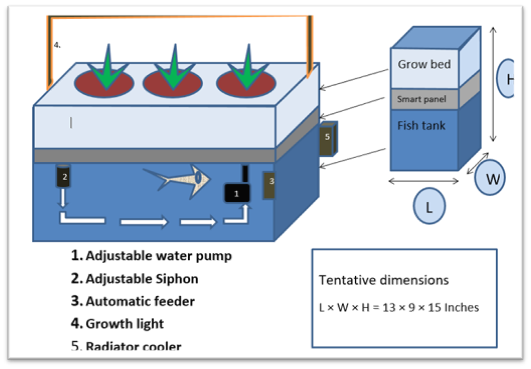Development of a Fully-Automated Portable Mint-Aquaponics for Urban Farming
BY Mr. Rajitha Hemachandra

Smart Aquaponics
Aquaponics is an eco-friendly system to cultivate fish and crops without soil by utilizing aquaculture and hydroponics. In this process, Plants take benefits of nutrients from fish feces, while the fish uses clean water filtered by the plant roots. On the one hand, with the advances in technology and the improvement of people's living standards, they have no more extra time and labor for regular watering and fertilizing plants. On the other hand, it is not easy to maintain water quality parameters frequently. Therefore, it can be understood the whole process is so complex and time-consuming. Considering the above shortcomings, the fully-automated mini aquaponics system is proposed. Firstly, in this study, it is important to select suitable hydroponic plant species which have the best water purification efficiency and growth efficiency. Next, develop a fully automated aquaponics system model. In this study, it is developed a smart aquaponics system that can synergize fish farming and plant growing by continuously gathering data from various aquaponics sensors, monitoring the sensor information, and controlling the system accordingly. In addition, the proposed system can notify the user if any abnormality occurs in the system via a smart display (Kyaw et al, 2017).
Plants that are planted in hydroponics systems are called hydroponics plants. Hydroponics is a technique of growing plants in nutrient solutions with or without the use of an inert medium (ex; gravel) to provide mechanical support (Nisha et al., 2018). Among the Mint plant verities, Spearmint (Mentha spicata) is selected in this study. That is why, spearmint may be very useful as biological filters in aquaponics systems to absorb and prevent the accumulation of nutrients produced by fish excreta (Carlos et al., 2018). And also, spearmint has been used as medicine due to their antiseptic properties. As an example, Mentha spicata is a natural repellent for Anopheles stephensi (Rafael et al., 2018). Several warm water and cold water fish species are adapted to recirculating aquaculture systems (P.S.Ranawade et al., 2017)Therefore, guppy fish is selected for this project due to they are quite tolerant of a variety of water conditions. It suggests that guppies have the capacity to survive and multiply in both fresh and polluted water (Shahjahan et al., 2013)
Figure 1. explains the overall system design. The fish tank, grow bed, adjustable submersible pump (1) work as an aquaponics system. Adjustable siphon (2) bring filtered water by roots from growing bed to the fish tank. An automatic feeder (3) has been programmed to feed guppy fish twice a day. Growth light (4) provides a light spectrum similar to that of the sun for plants in the grow bed. Water temperature will be kept at a constant level at 25 C0© with the aid of a radiator cooler (5). The hardware used is Arduino Uno as a microcontroller. It is used to store data from collection nodes (sensors), process data, maintain the changed water quality parameters by optimum values and then upload them to the mobile application. Water level sensor for alarming at low level and high level of storage water In the system, pH sensor to detect the pH value of the fish tank, temperature sensor to detect the temperature of the fish tank and DO (Dissolved Oxygen) sensor to detect dissolved oxygen level in the system is used in this aquaponics system. An extra water reservoir is there for the water level in the smart panel (figure 1.). Here, a pH sensor control module with BNC electrode probe support to maintain the pH level in an optimum range for guppy fish (6.5-8.5). Aerators are programmed to switch on when the DO sensor makes to alarm the system. There is an alarm unit for this system. The alarm unit consists of a green LED light, a red LED light, and a buzzer. This unit displays a green light when the system is healthy but displays red light with a buzzing sound to alert the user when the system is unhealthy. This section helps users when they maintain the aquaponics system physically.

Figure 1. Overall system design
Objective of the project
Develop a fully automated portable aquaponics system.
Project members : Mr. Chathura Roshan, Mr. Charitha Dias, Mr. Nuwan Liyanage
Location : Uva Wellassa University
Duration : 6 months
Doners : Uva Wellassa University
Partners : Randika Aquarium Farmhouse

